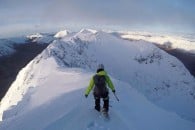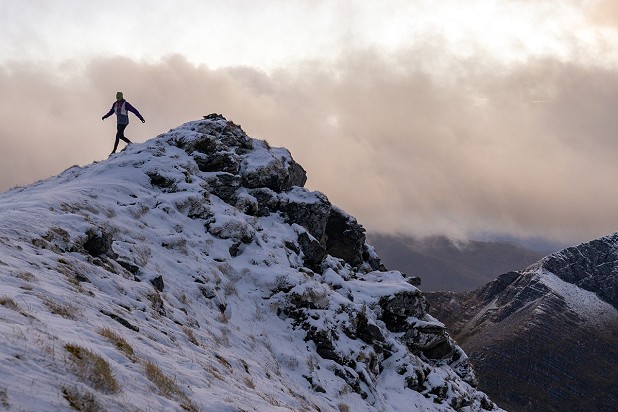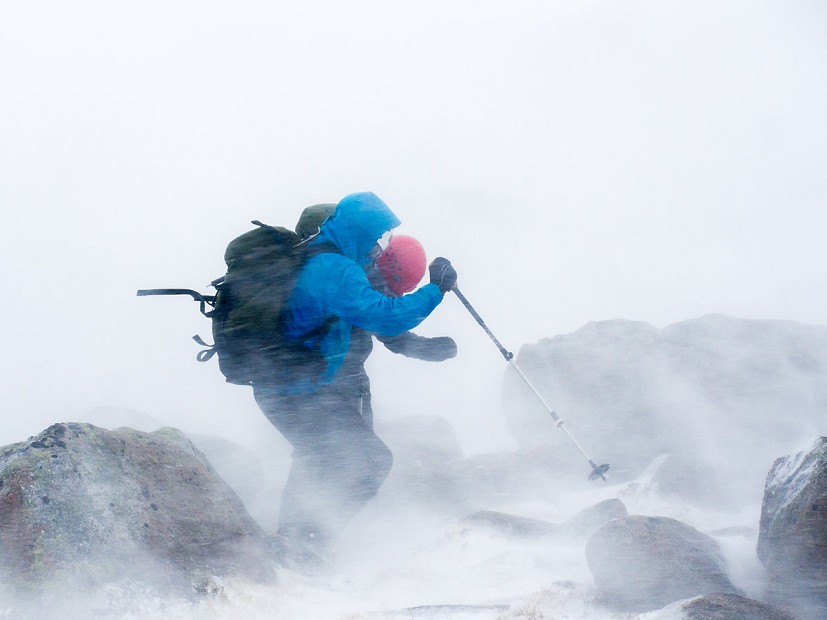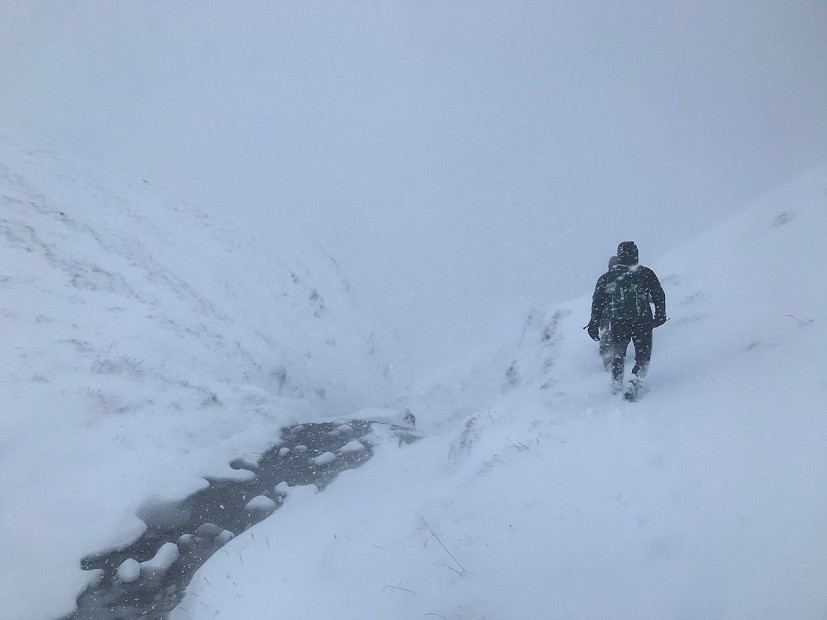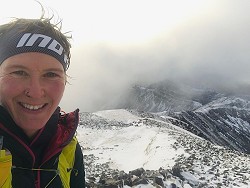Walk Before You Run - winter skills for hill runners
There are a lot of strong runners out there, but those coming to winter hill running without a grounding in appropriate mountain skills may not appreciate the severity of the challenge posed by snow on the hills, says fell running guide Keri Wallace. Here she discusses safety advice for winter hill running, looks at the specific demands of Scottish winter, and seeks top tips from the pros about how to get started.
Since the very first race cancellations, every bargain-basement Nostradamus was predicting that 2020 would be 'The Year of the FKT! says Ally Beaven in his recent book, Broken.
And so it was. More runners than ever before were hitting roads, trails and hills all over the UK, as an easy way to stay fit in lockdown. But for those already hooked on the sport, the absence of races left a motivational void that needed to be filled, and it was only natural that trail runners would begin to turn their minds towards personal challenges old and new. And how the records tumbled! So much so, that as the summer of 2020 drew to a close, it was quite clear that the year had been a remarkable one for British trail, fell and ultrarunning – a piece of history.
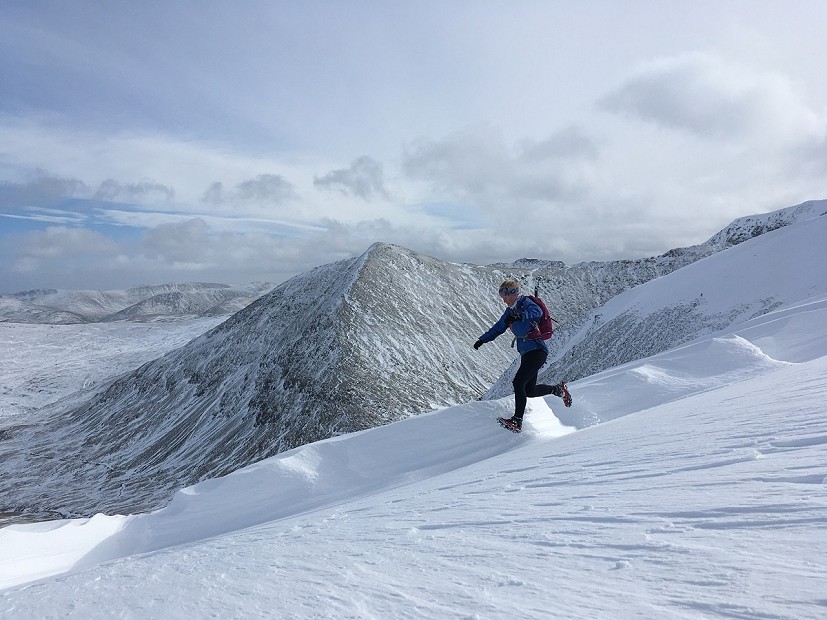
Then came the first snow. And after all the restrictions, those of us able to travel are not going to let a bit of the white stuff stop play.
But winter running is a discipline in its own right, and many of the records broken in the summer of 2020 have winter counterparts. Already the winter running and winter round attempts have started, so now seems a good time to consider how runners can stay safe in the winter mountains.
We are bombarded with images of 'influencers' and elite athletes zipping about the snowy mountains under a perfect blue sky. It is easy to forget the experience and ability behind them
The Scene
Winter fell running has historically been the province of the elite, with the first sub 24h winter Bob Graham Round falling to Selwyn Wright on midwinter of 1986. But today, all manner of trail runners are taking to the hills in all seasons, and with varying degrees of knowledge and equipment.
In the continued absence of races, it is likely that we're going to see a lot more runners taking to the mountains this winter.
"Many local fell runners will have a fair idea of their limitations in winter, but we are seeing a rise in trail and ultrarunners from outside the area who are strong runners but who don't have the necessary experience for making that transition" says Lake District-based Charlie Sproson, Director of Mountain Run.
"The outcome is that we have more unskilled runners, dressed lightly for the conditions, who may not know how to use their axe well in an emergency situation or know the limitations of the spikes on their feet".
There is also likely to be an increase in more experienced fell runners (some new to the winter mountains), attempting winter rounds and chasing winter FKTs.
Runners without experience of the winter mountain environment are more vulnerable to errors of judgement known as heuristic traps (flawed rules of thumb), which put them at risk. These behaviours include self-justifications such as 'I've done this route before and it was fine' or 'I haven't been able to get out much and I don't know when I'll get this chance again,' or 'someone else has run this recently and they were ok', or 'there is kudos in chasing this FKT'. But by underestimating winter in this way, it is easy to make compound errors.
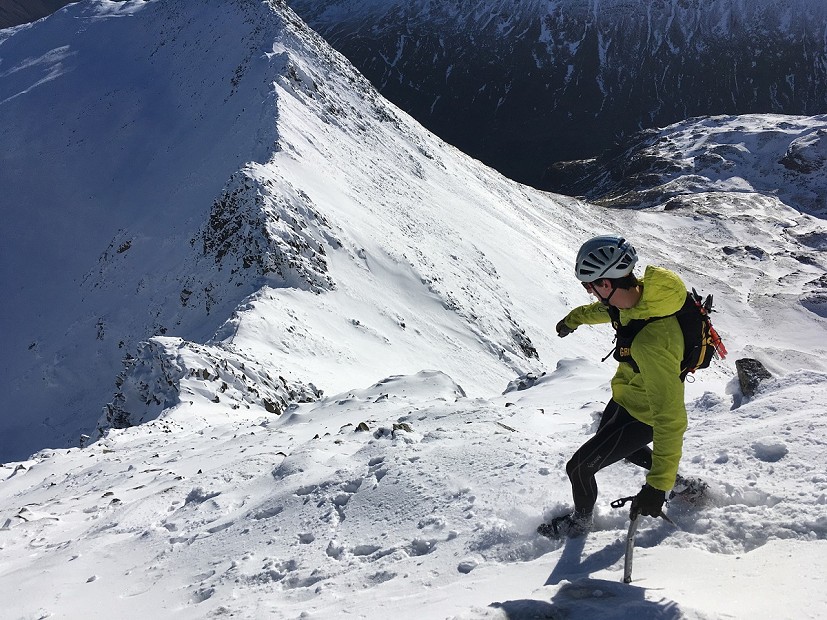
"This is the process of making minor error after minor error, each passing unnoticed until you find yourself in a situation that is all of a sudden very serious. In the event of an incident, it is essential to have more clothing and carry a bothy bag etc, but it's unlikely that most runners are carrying this level of winter gear," warns Sproson.
Winter mountain running can be a risky business and you need to be on top of your game. Are you? Check yourself against these three E's of winter - Environment, Equipment and Experience - and find out why you need to learn to walk before you can safely run.
Environment
We trail runners are not stupid; we all know that winter is colder and darker. We probably also know that running on ice or in snow is generally harder work. But in the mountains, there's a lot more to it than that.
At any time of year, the ambient temperature at the summit of a mountain will be several degrees colder than in the carpark, with winds two to three times the strength. In winter, this can mean heavy snow, tortuous winds and zero visibility on the tops, even when things were actually quite manageable when you left the car. Couple these dangers with deep snow, avalanches, cornices, sketchy ice and a rapidly approaching sunset, and things are starting to feel pretty serious.
In general, winter conditions in the Lake District and Wales are less consistent than in Scotland. "The weather systems that dominate in Wales tend to hold more moisture and are generally slightly milder, which means that any snow that does fall may not linger for long" says Kate Worthington, Winter Mountain Leader and UKA Fell and Trail Leader, RAW Adventures. On occasion however, conditions in both Wales and the Lake District can be just as severe as further north, demanding the same level of skills, equipment and commitment.
"The higher summits (particularly in Snowdonia) hang on to harder snow and ice for longer, whereas the lower elevations lose snow cover more quickly. This means that fell runners can get caught out when the area doesn't look very 'wintry' from the valleys, but winter skills are still required" says Worthington.
Consider doing a lot of winter hillwalking in a variety of areas and weather conditions before starting to plan winter hill-running days
Winter in Scotland
The climate in Scotland is significantly different to the rest of the UK. There are fewer daylight hours (just 6 hours on Ben Hope mid-winter) and colder temperatures, plus more snow more often - resulting in the build-up of snow and ice. These conditions allow for the formation of considerable cornices and a deep snowpack for much of the season. Scottish snow is prone to instabilities on account of the changeable weather, which can and does result in avalanches. Last year 27 people were caught in (human triggered) avalanches in Scotland, according to an SAIS report. None of this may be news to the majority of hillwalkers, but these are factors that trail runners rarely think about.
Signing up for a practical avalanche awareness course is the best way to learn about the risks of unstable snow, as well as using the Be Avalanche Aware app and being able to interpret Scottish Avalanche Information Service reports. This recent article may also be useful:
But even armed with this knowledge, weekend warriors visiting mountainous areas still need to do some research. Runners require an understanding of the historic weather and snowfall (over the last few days and weeks) to predict whether conditions underfoot will be 'runnable' and identify likely hazards on the route - such as avalanche risk, water-ice, strong winds, verglas or deep snowdrifts.
"As a runner, you can only really know what you can 'get away with' when you have experience of the full range of possible conditions" says top Scottish fell runner and Winter Tranter Round record holder Finlay Wild:
Equipment
The 'fast and light' approach that runners take to moving in the mountains comes at a serious price in winter. Runners tend to wear and carry fewer warm layers than hillwalkers, we may carry less food and we probably sweat more. We also move with greater momentum over the uneven ground. All this makes us more vulnerable to injury and rapid cooling. In other words, the stuff mountain rescue nightmares are made of.
Winter is simply not the time to push 'fast and light' to the extreme. Instead we all need to think more about what we carry, and take more layers.
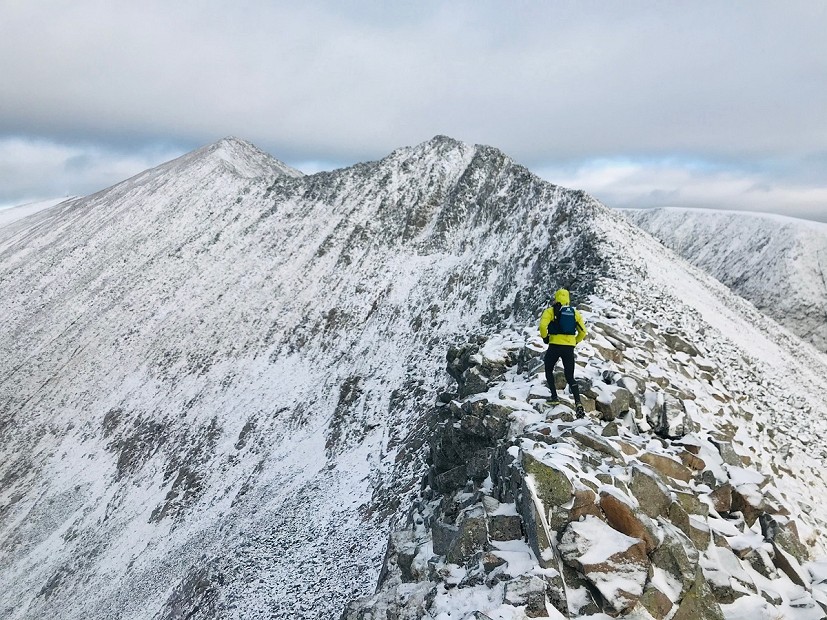
"Whether you are a hill walker or a runner you should always carry a map and compass, warm insulation jacket, group shelter and survival blanket (Blizzard are probably the best), first aid kit, spare gloves, goggles, snacks, more snacks, chocolate and more snacks" recommends Ali Rose, Mountain Safety Instructor for St John Scotland & Mountaineering Scotland (WMCI).
The fusion of mountaineering knowledge with fell running experience is pretty niche, and falls into a grey area outside the remit of current Mountain Training qualifications. We see this progression as a personal learning journey that cannot be safely circumvented
There are a number of further considerations that are specific to runners. For example, trail running vests are typically lower in volume than walkers' backpacks, and it is common for hill runners to stuff them full to their limits, but still carry far less in terms of layers and safety equipment than walkers. Certainly it would be worth investing in a bigger vest or a running bag for winter outings. Runners (in trail shoes) are also more vulnerable to cold feet, which can be debilitating if you're out all day in wet snow, very cold temperatures or strong winds. There are a number of solutions such as layering natural fibre, waterproof or neoprene socks, using waterproof shoes/boots or a combination of the above – but success largely comes down to experience and personal choice.
Depending on the snow/ice conditions, fell runners may also need to carry a lightweight axe and crampons. There is a wide range of traction devices available on the market that will fit over a running shoe, ranging from simple slip-on devices like Yaktrax to semi-flexible 10-point running crampons.
Microspikes are a popular choice for trail runners. They are fantastic bits of kit for running on low-level icy trails but you can quickly become unstuck wearing them in the mountains. The difficulty is that they are really comfortable and offer great traction over the majority of upland terrain (not to mention, you don't need to run like John Wayne to avoid catching your own trousers), but in certain circumstances (particular gradients and snow/ice conditions) they can be extremely dangerous. Here's an article on that subject:
A running axe is also useless if you don't know when to have it out, or how to ice-axe arrest (in fact you're more likely to just impale yourself on it at top speed!). There's a lot more to using an axe than a winter novice might assume:
So how can runners go about acquiring the skills and knowledge they need to safely take their running into the winter mountains?
Experience
Last week saw the launch of Mountaineering Scotland's THINKwinter campaign, a valuable source of safety advice for anyone looking to venture into the winter mountains in Scotland. Much of these resources are aimed at walkers and climbers, but it is more important than ever that this best practice advice is brought to the attention of hill runners as an extension of the mountaineering community, and as a growing demographic that has hitherto slipped through the cracks.

Skills courses
In the last few years, the first winter skills courses aimed specifically at runners have started to appear in the UK.
"We are seeing an increase in trail runners who want to access the winter mountains but don't know what steps to take or where to start," says Sproson. "We think it's important to educate people in how use the equipment they are carrying correctly, since they are going to do it regardless!" Mountain Run offers Winter Mountain Skills for Runners courses in the Helvellyn Massif, covering winter navigation, kit choice, and the use of ice axe and running crampons.
But Sproson makes an important clarification: "We teach the key competencies but it always comes with a hefty safety warning about where and when this can be applied geographically. Our courses should be seen as part of a 'winter apprenticeship' only and are not a replacement for a full winter skills course if you're planning on venturing into the high mountains or on to technical terrain, in Scotland for example" he says.
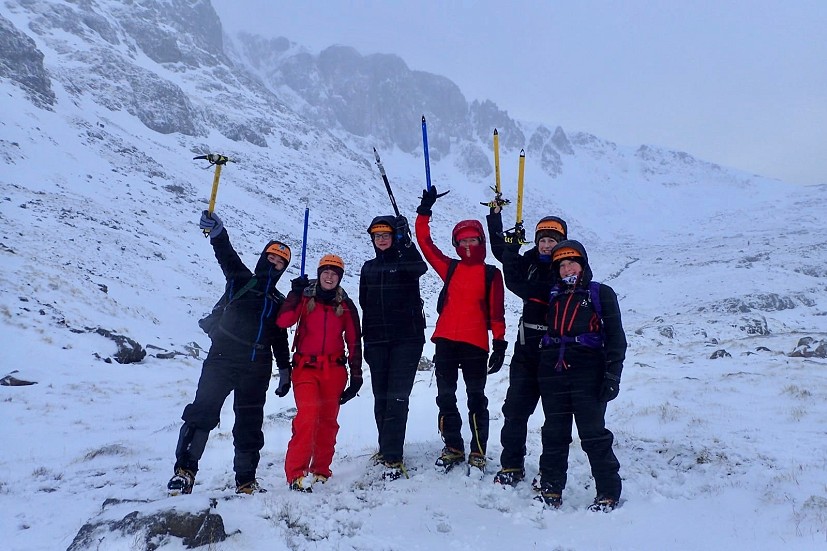
In contrast, our trail running company Girls on Hills (based in the Scottish Highlands), offers low-level Winter Trail Running courses that demo microspikes and teach the limitations of basic winter mountaineering equipment. "We feel strongly that in Scotland it is more appropriate that runners develop a base of experience through traditional winter skills courses aimed at hillwalkers" says Nancy Kennedy, Co-Director of Girls on Hills.
"The fusion of mountaineering knowledge with fell running experience is pretty niche, and falls into a grey area outside the remit of current Mountain Training qualifications. We see this progression as a personal learning journey that cannot be safely circumvented."
"A traditional winter skills course helps to add techniques, knowledge and confidence to the running toolbox says Kate Worthington.
"Personal experience is quality learning but with added input from an experienced and qualified instructor, runners new to the winter mountains can learn skills drawn from winter walking and mountaineering that will help inform judgements and decision-making. The assessment of risk and consequence is a massive priority in the winter months."
"It is essential to then use, practice and extend those skills by getting out with trusted running partners over time" adds Worthington.
It is more important than ever that best practice advice is brought to the attention of hill runners as an extension of the mountaineering community, and as a growing demographic that has hitherto slipped through the cracks
Winter knowledge
While some technical skills might take little time to master, elements like winter navigation and route planning take many years to hone and are fundamental to safe travel.
"I would recommend doing a lot of winter hillwalking in a variety of areas and weather conditions before starting to plan winter hill-running days" Ali Rose advises. This article should give you some idea of the range of skills and competencies that runners should be looking to develop through a hillwalking 'apprenticeship':
"During the planning phase, hill runners need to be able to use the map to identify and avoid slopes that would be unsuitable for trail shoes and running spikes, as opposed to a solid boot-edge and crampons" says Rose.
But if conditions turn out to be less passable that expected, "runners need to respect the limits of their basic equipment, and be willing to change the route plan or turn back."
In practice, it is safest to avoid donning microspikes out of necessity, where upward progress would otherwise not be possible. Ascending will often be easier than descending snow or ice, and conditions can change rapidly. In this kind of situation, you simply can't guarantee that your route choice will be reversible in microspikes - and being able to retrace your route is a fundamental adage in winter.
The majority of runners own and use GPS enabled watches or devices, and it is very much the norm for these to be used for navigation in races and on long-distance trails (and even on mountain rounds). In winter it is far safer to plan your own route in the mountains than to blindly follow an established round or gpx track for a popular route that takes no account of the current ground and weather conditions.
Skilled use of a map and compass is the only reliable way to navigate in winter. This is a skill that many fell runners possess, but by no means all runners. However, navigation in winter is considerably more difficult than in summer and involves a number of unique mountain safety considerations (it's no longer about simply getting from A to B). Low visibility when combined with snow can result in a very disorientating situation known as a 'whiteout'; the depth of snow will impact estimated timings; and bearings must be accurate and planned to avoid possible cornices at all cost.
"Until you've walked on a bearing in a white-out or a blizzard, and understand where to expect cornices, you can easily find yourself in trouble. You might not see even see the lip, before you're already off down a coire" warns Finlay Wild. Night navigation skills are also likely to be called upon, on account of the shorter days.
Winter-specific navigation skills courses are a great way to upskill and ensure that your map and compass skills are fit for purpose. And here are a few navigation skills articles, for starters:
How to get started
In an era where social media is all-pervasive, we find ourselves bombarded with images of 'influencers' and elite or professional athletes zipping about the snowy mountains under a perfect blue sky, taking it all in their stride. It is easy to forget the considerable experience, knowledge and ability behind what we see.
"When I attempt a winter FKT in good weather, on a route that I know well, I might decide to pare down my equipment, with corresponding narrowing of safety margins - although this would be a careful decision based on conditions, weather, route, my experience and other factors" says Finlay Wild.
But it is important for us to remember that Wild has decades of Scottish winter experience, starting with hill-walking and winter climbing and progressing into winter running. In 2016 he broke the Winter Cuillin Ridge Record and was also British Skimo Champion the same year:
We all have to begin somewhere
"Firstly, don't be put off" says Damian Hall, Inov-8 athlete and winter Paddy Buckley Round record holder. "Some of my best running memories are winter ones. Of course, you want to be more aware of the weather forecast, more aware of where you'll run, and have good navigational aids and know how to use them - plus spare layers and plenty of calories. Also tell someone what you're doing; ideally share your intended route, with rough timings and an expected finish time (and make sure they know how to notify mountain rescue). And have a Thermos of tea waiting in the car"
"I would always recommend some form of traditional winter apprenticeship," says Wild. "An incremental progression is not only going to make you safer, but it's much more rewarding. And these skills are best learned with standard mountaineering equipment" he adds.

"Sign up for a winter skills course to learn how to move safely on snow and ice" agrees Kim Collison, winter Bob Graham Round record holder. Collison learned his winter skills through many years of hillwalking and working as an instructor for Outward Bound in Scotland. "Always be prepared in case you do have an accident, plan a route within your comfort zone and skill level, then build up experience and confidence gradually."
"We all have to push boundaries to gain knowledge and experience, plus we learn by our mistakes, but by rushing, you risk getting into situations that are well above your limits! Go out with contemporaries, learn from organisations geared towards these skill sets and activities, read books, make sure you head out with a buddy in the hills (two minds are always better than one), and always have a good plan. Ideally have a plan A, B, C and D and of course remember that it's better to turn around and come back to fight another day, than press on and not return at all" advises Sproson.
"I would recommend familiarising yourself with winter conditions, become competent in using axe and crampons and then choose the best weather possible, anytime you're trying something that you might find challenging" says Helen Rennard, women's winter Tranter Round record holder. Helen is an accomplished Scottish winter climber and would be the first to describe herself as a mountaineer rather than a runner.
"Using fenceposts, camera tripods or sharp stones as improvised axes in a desperate bid to negotiate that last patch of neve is just wrong - don't do it!!" says Lochaber runner Jon Gay, the first person to complete a winter Ramsay Round in under 24h. Gay took a couple of 'years out' to indulge his passion for alpine and winter climbing before taking up a 9-5 job and hill running.
The winter mountains are a fabulous playground and they are open to everyone. It may take time to build competence and confidence, but as with any successful endeavour in the mountains, the fun is in the journey.
About Keri Wallace
Author Keri Wallace is a trail and fell running guide for Girls on Hills. Keri has over a decade of winter mountaineering and Scottish winter climbing experience in her local hills, including avalanche awareness courses, winter skills courses and 5 years' experience on the Glencoe Mountain Rescue team, attending winter callouts and avalanche rescues. All Girls on Hills Winter Skills courses are delivered by WMCI and WML qualified instructors.
